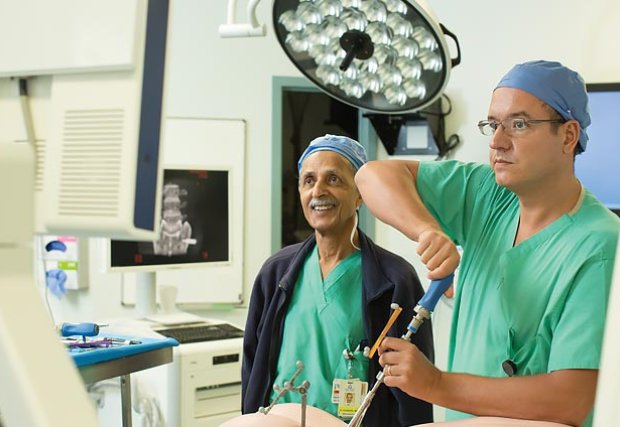Neurosurgeon Syed Hussain, MD, and Neurosurgeon and Chief of Surgery Jaime Gasco, MD, test out the StealthStation® S7®.
McAllen Medical Center is the first hospital in the Rio Grande Valley to equip neurosurgeons with an intraoperative surgical navigation and imaging system.
The devices work together to help neurosurgeons maintain seamless visualization of the spine during surgery. This is accomplished by combining multiple modes of imaging data into virtual maps that help guide the neurosurgeons.
A patient’s anatomy can be viewed right from the operating table, and surgical changes can be verified prior to the patient leaving the surgical suite. As a result, patients undergoing elective or emergent spinal procedures may experience less invasive surgeries, faster recovery times, and improved outcomes. If needed, the equipment can also be moved to the trauma bay or the operating room, so the patient can stay in one place.
As a designated advanced Level III trauma center for Hidalgo County, having this equipment can save precious time for patients with critical injuries. In some instances, patients do not have to get imaging done in the radiology department prior to surgery because the O-arm® 1000 and StealthStation® S7® can provide doctors the images they need.
“Time is critical in the operating room, especially in instances of trauma,” says Jaime Gasco, MD, neurosurgeon with Valley Care Clinics and Chief of Surgery at STHS, who was the first physician to use the system at McAllen Medical Center. “Neurosurgeons can plan their approach and precisely track the location of surgical instruments. Having the most sophisticated intraoperative navigation and imaging equipment help us do a better job.”
Other neurosurgeons Syed Hussain, MD, and Alejandro Betancourt, MD, regularly use the system and believe it is a great addition to the already robust and comprehensive trauma and neurosurgery programs at McAllen Medical Center.
Dr. Betancourt says the O-arm offers multidimensional images in about 30 seconds, and provides surgeons with real time 2-D and 3-D imaging not offered by other available technologies. “Experience still matters, though. The neurosurgeon chooses the approach, the tools, the positioning of the tools and is in complete control. But now we have a better map,” he says. Dr. Hussain says, “This new equipment will have a tremendous impact for patient care here at McAllen Medical Center.”


